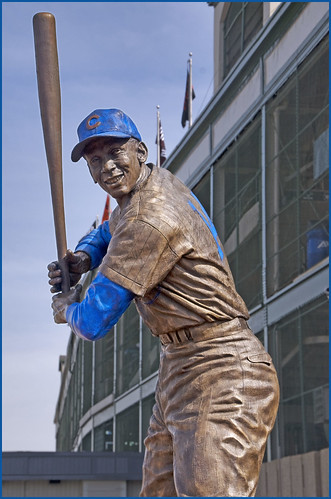I didn’t know this until nearly two days after his death, but Ernie Banks, aka Mr. Cub, essentially was the first player to break the color line with Chicago’s National League baseball club.
Sports writer Joe Posnanski explains:
At that time in the National League, just about every black player played in New York, either for the Giants or Dodgers. There were no black players on the Philadelphia, Pittsburgh, Cincinnati or St. Louis teams. Or Chicago. It was September 1953, and Chicago Cubs owner Phil Wrigley was so distraught about his team’s awfulness that he told the press he would happily sell the team, “if the right buyer came along.” Attendance at Wrigley Field was down a quarter of a million, the Cubs were 40 or so games out of first place, they had blundered into acquiring slugger Ralph Kiner just as his career was going over the cliff. Hopelessness hovered over the Chicago Cubs like a rain cloud.
Enter Ernie Banks. In the past, teams like the St. Louis Browns had brought in black players into exactly this kind of baseball morass, brought them more for publicity than baseball. The Cubs called up two black players that day in 1953, the other a 28-year-old second baseman named Gene Baker, who would go on to a fine career. Banks, though, got into a game first. In his first at-bat, he flied out to center off of Phillies star pitcher Curt Simmons. That day, Banks would go zero-for-three with a walk. He also made an error. The Phillies beat the Cubs 16-4. A Cubs career had begun.
Now, it should be said the Chicago White Sox broke the color barrier a year or two before the Cubs. But the remarkable thing was despite being a pioneer, Banks was beloved as a Cub almost right away. And his enthusiasm for playing certainly played a part.
Incidentally, that’s the second sports icon to die in a Route 66 town in two years. Stan Musial, who was Mr. Cardinal in St. Louis, died about the same time in 2013.
People who look at Banks’ career will note he wasn’t as productive after the knee injury caused him to move from shortstop to first base about age 30. And he probably will always be known as one of the greatest baseball players to never have played in a World Series.
So it’s understandable people may have taken pity on him. But Banks’ situation also reminded me of another Hall-of-Famer, quarterback Joe Namath, who also played on poor knees and poor teams.
“I never played a healthy down of football in the NFL. I had a bad knee when I came out of Alabama. It only got worse the more it got hit on. But things turned out so well, I’d have to be a real jerk to start complaining now. […] I did pretty good for a skinny kid out of Beaver Falls (Pa.)”
You could also argue that Mr. Cub did pretty good for skinny kid out of Texas.
(Image of the Ernie Banks statue at Wrigley Field in Chicago by Ron Cogswell via Flickr)
